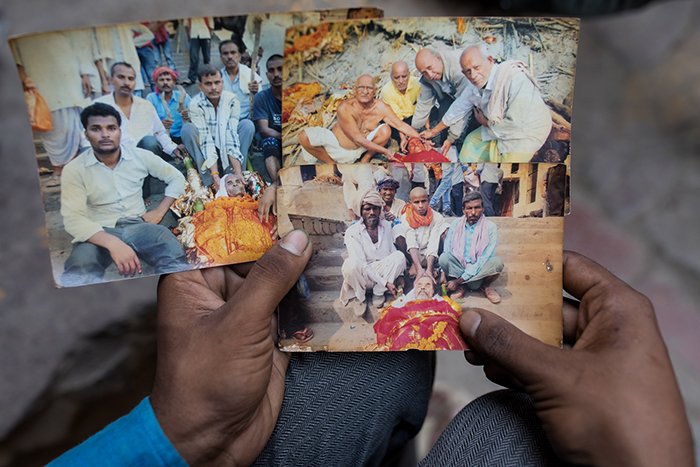PHOTOGRAPHER OF DEATH - The last portrait

Photographing the dead is his job.
Niraja, a 20-year-old, manages one of the photo studios situated in the bustling streets of Varanasi, the world's oldest inhabited city.

Niraja awaits the families during processions leading to the crematorium. If fortunate, he may receive a few rupees from clients seeking pictures of their loved ones. Kashi Manikarnika Ghat, located alongside the Ganges River, is one of the holiest cremation sites. According to Hindu mythology, the act of cremation symbolizes both creation and the destruction of humanity, granting immediate liberation from the cycle of rebirth when performed in Varanasi. Cremation along the banks of the Ganges is considered the highest honor by the local community.


The air is thick with smoke carrying the scent of burning wood and flesh, permeating clothes with an odor that lingers for days. The only sound is the echoing chant of "Raam Naam Satya Hai" (the name of Ram is true) resonating within the mud walls, accompanying the departed on their final journey.

The Ghat operates 24/7, hosting hundreds of cremation ceremonies daily. Death sustains livelihoods within the community, with wood merchants, barbers, priests performing rites (Antyeshti), florists, and outcasts scavenging through mud for the belongings of the deceased. Among these roles are the death photographers, tasked with capturing the final moments of the departed before their cremation.

While unconventional and potentially disrespectful to some, for Varanasi's photographers, it is simply a means of earning a living. Families often encourage the practice, seeking closure for those unable to attend the funeral and as evidence for legal matters since death certificates are not provided by crematoriums.


Naraja has been in this profession for over five years, a legacy passed down through generations in his family. He possesses two cameras, both damaged.
To take photographs he uses the one with the broken LCD screen, while the other one, which has the broken lens, he uses to view the photos.

Despite the unconventional nature of photographing the dying, it serves various purposes for families, including enabling absent members to witness final moments and providing evidence for legal matters such as inheritance claims.

Once Niraja completes the photography session and satisfies the family, the cremation ceremony commences. He then rushes to a lab outside the city to develop the images, as missing the family's departure without delivering the pictures means no profit for him. For Niraja, this moment is crucial, requiring swift action to develop and deliver the photographs promptly.


Niraja reflects on his passion for photography, emphasizing the importance of capturing emotion rather than mere visuals. Despite the challenges, he feels honored to undertake his role.

As I observe Niraja, I sense his struggle to encapsulate the essence of each shot, yet his ability to elegantly capture the intertwined concepts of life and death is truly inspiring. In Varanasi, these concepts are inseparable, and being cremated along the banks of the Ganges is a cherished dream for many.
!LUV
mauro-debettio, barnabo73 sent you LUV. 🙂 (1/4) tools | trade | connect | wiki | daily
Made with LUV by crrdlx.
Thanks !
Cool... I hsve seen in videos that this city is very big also 😯👌👌👌
But very cool photography post ... I try be soon back to see more what you post 😋👌👌👌☕☕
Very kind, thenk you very much
Interesting photos!
Many thanks !
Super
Thank you !
G